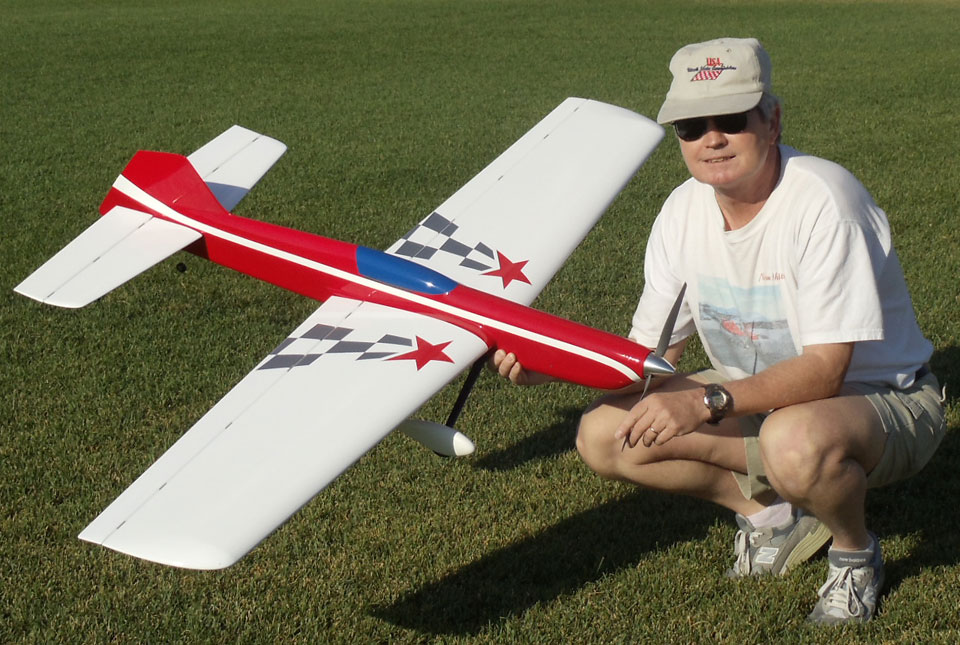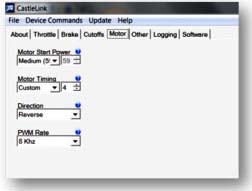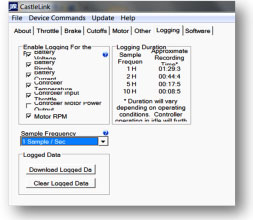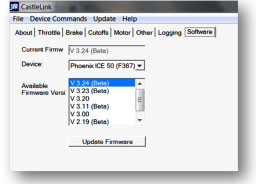

Norm Whittle of Layton, Utah, shows off the Elegant Sultan e. All photos and charts provided by Norm Whittle.
Cookbook for the AXI 2826/12 and Castle ICE 50 Lite & FM-9 series of Timers
Rev: 1.8.1
Date
04/01/2011
By: Norman Whittle
This is a quick setup for Control Line Stunt using the AXI 2826/12 motor, the Castle Creations ICE 50 Lite ESC, 5S (5 cell) 2600mah battery and the Will Hubin FM-9 timer as an example. The set-up as described has been tested on my Sultan-e and runs extremely well up at 4650' and equally well down at 200' MSL. Typical power consumption for a 5 min 30 sec flight using an APC 13 X 4.5 EP prop running at 9500 RPM is 1550 - 1650mah. I also have included a connection diagram suggesting
methods that work for me. The suggested connections are a minimalist setup, figuring the reduced number of connections, the less solder joints, the more reliable the system should be. It does not use a resistor for
spark suppression, as this is just more complication that is not needed. Sparking is only localized to the
connector and any resulting carbon tracks can easily be cleaned with fine steel
wool. The basic tenets of this set-up can be used on a variety of
combinations such as AXI 2826/10 with 4S batteries or even Plettenberg Orbit
20-16 or - 12. I have used this
setup on a Plettenberg 20-16, 5S battery and ICE Lite 50 with great success. The components used are:
Motor: The AXI 2826/12 is a 14 pole motor; Kv
760, Maximum efficiency 84 %; Maximum efficiency current 15 - 25 A; Current capacity 37 A / 60 s; Internal Resistance .062 ½; Shaft diameter 5 mm (.196"); Dimensions (D x L) 35x54 mm (1.38 X 2.125"); Weight with cables 181 g
or 6.385oz.
ESC: The Castle Creations ICE Lite 50 ESC; Length 40.6mm (1.6") Width 26.4mm (1.04") Height 12.7mm (0.5"); Weight 22.7g (0.8 oz); Max amps 50 amps (5 amp BEC); Max volts 25V 6S LiPo.
Battery: ThunderPower 5S 2600mah; Dimensions (W x
H x L) 42 x 34 x 102 (1.65 x 1.34 x 4.01); Weight 292g (10.3 oz); Charge at
2.6A (1C); Voltage nominal 18.5V; fully charged voltage 21 vDC or 4.2 vDC per
cell.
Other Required Items: Castle Creations "Castle Link" software that is downloadable from the following link Castle Creations; a Field link card with USB cable or a
Castle Link with USB Cable card is used to exchange information with the ESC.
- Charger: A Charger designed for Lipo
batteries with balance connector to monitor individual cells when charging. The
Charger I use is the Venom Pro available from Tower Hobbies but maybe a better
solution might be the ThunderPower TP610C-AC/DC 1-6 Cell LiPo AC/DC Charger
w/Balancer about $120. It comes
with the correct balance connector for the ThunderPower battery.
- Connectors: For the Battery to ESC - I use the W.S. Deans 2-Pin Ultra
Plug. For the motor to ESC and
Arming connections I use - Great Planes Gold Plate Bullet Connector Fem 3.5mm
and Great Planes Gold Plate Bullet Connector Male 3.5mm. The male connector can be soldered to
the wire at a 90 deg angle. This
is useful in constructing an arming plug.
Interconnection diagram Fig 1.
Now that you have everything connected, let's connect the ESC via USB port to the computer. The "Connection Status" in the bottom left hand corner of the Castle Link software should turn green. The software will
recognize the type controller and firmware installed in it. It may ask you to update the firmware
to the latest version. Eventually you will need to do it so let's click OK. Firmware will update.
Now click on the "Throttle" Tab; we want to go to Control line for "Vehicle Type"this will enable both the Governor and Brake simultaneously. "Throttle Type+ = Governor Mode. No need for Throttle response. Dropping down to the box labeled "Vehicle Setup Information" click on "Calculate Battery Volt" it will ask you volt per cell and the number of cells. Input 3.7 v and 5 cells
respectively. Now click "Enter Motor/Gearing Inform" it will ask for number of Poles = 14 and input 1/1 gearing also it will ask for the Kv rating – in our example it is 760Kv.
I have input three samples of "Desired Head SP" in RPMs. These will be useful when programming the timer.
Now back to the box labeled "Governor Mode". Since we are using the AXI 2826/12 and it has 14 poles, we will use "Governor H". If we were using, for example, a Plettenberg 20-16 with 10 poles we would need to set to "Governor L"; this in effect evokes a different throttle curve. "Governor Gain" is next in the example - I have selected High (35) gain. I have tested this set-up
using Custom (45) governor gain with excellent result. This function is really how hard the
governor will try to hold the set RPM. One thing to watch for is the motor oscillating if the gain
is set too high.
"Head Speed Change" this is the governor response speed setting -- be careful here and move slowly up in gain, Custom (6) is still safe on my airplane listen to the Governor coming out of a hard corner, again listen for the governor oscillating or chasing its tail as I have heard it described.
"Initial Spool-up Rate" is how fast the motor will reach full power from start – could be useful for setting up
take-off speed and acceleration to take-off.
It should be noted that several folks use "Set RP" with great results and find that this function makes the ICE ESC. The
Castle Creations folks have a set-up procedure for this on their Web page.
Castle Creations Support Documents
Fig 2.

Let's go to the Tab labeled "Brake." I have tried different brake settings
and found these to work best on the Sultan-e. Quick clean cut off - prop stopped.
Fig 3.

Let's go to the Tab labeled "Cutoffs". "Cutoff Volt" is set to Auto Li-Po - this is a safe
setting. " Auto Li-Po Volts/Cell" 3.2 Volts/Cell is good (it shows 3.0 Volts/Cell but 3.2 is safer). With us using only about 1500ma we
should never hit either of those voltages. "Current Limiting" I payed for 70 amps - I'm getting it - but you could pay for that in a prop strike. If I was flying on grass I would change the Current Limiting
to "Sensitive (xxA)" or Very Sensitive (xxA). Another solution is to not tighten the
prop collet as tight as you can. So in case you get a prop strike, prop slipage will keep from burning
down your ESC.
Fig 4.

Let's go to the Tab labeled "Motor". "Motor Start Up power" not a critical item medium works well.
"Motor Timing" The ICE controller uses an advanced timing method where the timing is adjusted automatically based on load and RPM. The way the principle designer (Patrick del Castillo) suggests setting our timing isÉ "I'd suggest you bump the timing up slightly from "low" (using custom setting) until you get the power you want. The lower timing will give you a much more efficient and cooler running system (less wear and tear on the motor too!)"
What you see is my end result; I went from Custom (2) and stepped up incrementally to Custom (4). "Medium (5)" equates to approximately 18 deg from ZCO. I have heard the guys in the Czech Republic recommend 12 deg so a setting of 2-4 is somewhere in the right area.
"Direction" this is self explanatory.
"PWM Rate" set to 8 KHz but others have used 12 KHz successfully. 8 KHz is the most
efficient settings for a medium size outrunner. The general rule is the lower the motor's inductivity, the higher the switching frequency should be. Increasing the switching frequency reduces the ripple in the
current flow in part-load mode; but at the same time causes a rise in eddy
current losses in the motor and switching losses in the controller. These losses do create heat in both the
motor and the ESC.
Fig 5.

Let's go to the Tab labeled "Other." "Power-On Beep" One nice feature is that the ESC beeps every 20 sec when powered up or "armed"; since I set a delay of 22 sec on my Will Hubin timer, the ESC will beep 2 sec before the motor spools-up. Also, after landing and your helper forgets to "disarm" the ESC will beep every 20 sec until it is "disarmed".
"BEC Voltage" this provides voltage to the timer, 5V is correct unless you have a timer that requires more or maybe retracts that could use a higher voltage. Word of caution most timer's maximum voltage is 5.5 vdc so stay under that.
Fig 6.

Let's go to the Tab labeled "Logging". This is the section that you set what you want to
record. I would suggest on a new airplane you would set to record all you can and set the "Sample Frequency" to much higher sample rate so you don't miss any information. Maybe 5 or 10Hz but notice the
recording time will be only about one flight if sample everything at 10Hz. Of course I would suggest that the
first 3-4 flights are of 2 min duration. This will keep you from wasting time if it's not "just right".
Another solution to getting more "Data Time" is to sample at high rates such as 10Hz but to reduce the items to sample. Experienced
folks have told me that Current, Battery Voltage, RPM and % Throttle should
suffice.
"Logged Data" Click "Download Logged Da" and save the data to a folder on your computer then click "Clear Logged Data" to make room for more recording.
Fig 7.

Another example of
using increased sample rates is to fine tune individual maneuvers. The example below is from Mr. Peter
Germann fine tuning his Wingover by looking at the time it took the aircraft to
complete the maneuver (3.6 sec @ a sample rate of 5Hz). Of course this could have a direct
correlation to overhead tension if the airplane became slack on the line;
current would also vary. As you
start looking at the data more and more creative uses will become evident.
Fig 8.

Let's go to the Tab labeled "Software." "Available Firmware versi" - This window is updated when you download the latest version of "Castle Link". Castle Creations use "Castle Link" software to distribute their Firmware. So you need to log into their Web Site occasionally to check for Software updates that contain Firmware updates applicable for your ESC type. What did he just say? http://www.castlecreations.com/downloads.html
Just a note:
Firmware is what drives or controls the internal working of you ESC. The Software "Castle Link" is used to program the parameters that the Firmware uses in its program execution.
Fig 9.

Don't forget to update settings on the bottom right of the ESC screen
"Setting Control"
"Update" = send all the changes you just made to the ESC. If you don't tell it to update it won't do so automatically.
"Default "= Set all settings back to the factory settings.
The bottom left side of the ESC screen
"Connection Status"
USB is connected -
If Green - the USB board or Field controller is connected. Red = not connected.
Device Connection
Status - If Green - the ESC is talking to the Computer. Red = not talking.
Note: Also click on any "Blue?" to get additional info on that function
FM-9 Timer: Ok, let's look at the Timer setup. The primary function of the Timer is to send a pulse-width signal to the ESC for a given duration (flight time); thus, simulating an RC receiver input.
 Will Hubin, the
manufacturer of the timer used in our set-up, provides very good instructions
with his timer and has recently updated his controller box with a new
eeROM. If you don't have the latest chip (eeROM) you can order one from him for a nominal charge.
Will Hubin, the
manufacturer of the timer used in our set-up, provides very good instructions
with his timer and has recently updated his controller box with a new
eeROM. If you don't have the latest chip (eeROM) you can order one from him for a nominal charge.
For
our baseline setup you have several options to program in RPM. The simplest is just to use the direct
RPM input. If you are using Castle Creations Firmware 3.20 or earlier you can use the ESC MODE: "Phoenix High RPM". If you have updated your Firmware to 3.24 or later (higher number) you would use the ESC MODE: "Phoenix new High RPM" mode to set RPM's directly. I have found on my motor these settings are within 20-30 RPM tached.
Then there is the ESC MODE: "Phoenix Set RPM" this is a very popular option used by many of the East Coast fliers, although I have very limited experience with this mode. In the "Throttle" section I have provided a link to the CC page that explains the procedure. The FM-9 timer, in the ESC MODE: Phoenix Set RPM allows you to select one of three RPM that you can program into the ESC.
One other function is the ESC MODE: "Throttle Mode" you can program the RPM as a function of the percentage of power. This % of power closely correlates to the pulse-width information shown in Figure 3 under "Vehicle Setup Information". Looking at the second example the "Desired Head SP" = 9562 RPM the ESC calculates that you need a throttle setting of 1.430ms (milliseconds) the .430 portion of the number very closely equals to a power setting 43%. In practical
application on my Controller/ESC I noticed that the power percentage is about a
1% high in the throttle setting; so I would start a percent low and measure my
RPM. Example -- My desired RPM is 9562 the ESC needs a pulse-width input of 1.430ms. So, using my Will Hubin Timer Controller I select ESC MODE: "Throttle Mode" set my controller to 42% power and check my RPM. The RPM should be within 75 RPM of
desired, if not bump it up or down 0.5% and recheck. Once you get a feel for your combination this is a matter of
routine and you will quickly get to the required RPM.
One other new development for the FM-9 series of timers is the "Retract version". I recently received one
for testing and it works very well. I plan to use this version even if I don't use Retracts. If you do use Retracts -- this timer gives you the ability to pull up the gear from 4-59 seconds after spool-up. I would think for dramatic effect you
would want to pull the gear up after takeoff and two level laps. The Retracts then come down at the 5 sec
warning that you get near the end of flight. One nice thing about this timer it allows you to set
additional time, from 0 – 59 seconds, to maintain power after the 5
seconds warning; thus giving the Retracts ample time to fully extend. Of course this last function can also
be used without the retracts so if a 5 seconds warning is too short for your
taste then you can dial in a few additional seconds.
NOTE:
Always hold down the "Start" button when turning on the Controller for programming the timer. Will states
this in his instructions in bold.











 Will Hubin, the
manufacturer of the timer used in our set-up, provides very good instructions
with his timer and has recently updated his controller box with a new
eeROM.
Will Hubin, the
manufacturer of the timer used in our set-up, provides very good instructions
with his timer and has recently updated his controller box with a new
eeROM.